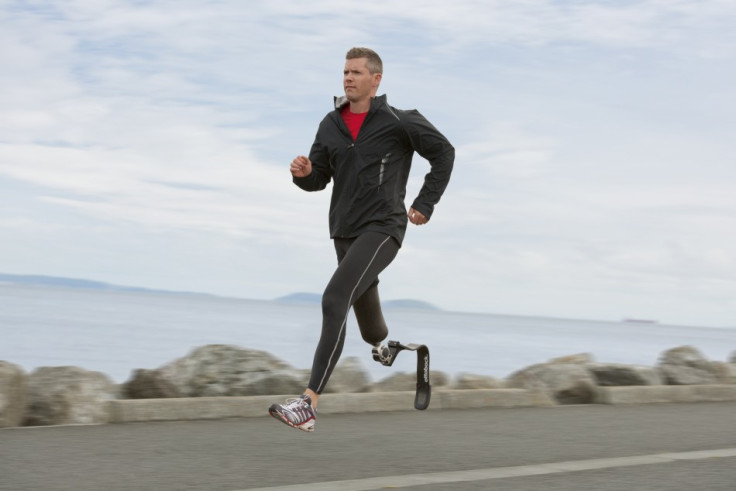London 2012 Paralympics: Otto Bock Launches Prosthesis for Everyday Sports Use
Medical technology company Otto Bock HealthCare has launched an artificial limb designed for everyday leisure use.

The sports prosthesis is designed to help amateur athletes with an amputed leg enjoy an active lifestyle. Optimised for running sports, it comprises the 3S80 Sport knee joint, 1E90 Sprinter Carbon Foot and the newly developed 4R204 Sport Foot Adapter.
"This fits the requirements of a leisure sport and that is very important. We do not produce something for Formula 1, we produce something for the normal person," said Andreas Samson, director of technology at Otto Bock.
However, given the technology that goes into creating a prosthesis, F1 is not a bad comparison.
For example, the knee has to be able to handle a controlled stand and swing phase, pre-flexion, support when walking upstairs or over obstacles, intelligent permanent static stance, sitting recognition and additional modes.
Meanwhile the foot handles shock absorption, fast plantar flexion, harmonic rollover, fore foot dynamics, effective foot length, torsional compliance, strength and stability.

Billed as something anyone can use to be more active, it has a price that is within reach of regular consumers.
"Most of the athletes use their day-to-day socket with the prosthesis. So when we talk about price in the UK we talk about the knee and the adapters to the foot and that is around £3,500," Samson said.
"In the UK the blade itself is probably around £1,500. So if you are looking at other Paralympic sports such as cycling or rowing the financial outlay for the technology is not huge in that respect," said former Paralympic athlete John McFall.
Try Before You Buy
Otto Bock does not want to offer equipment that will not be used and has designed a try-before-you-buy system using an adjustable tester kit to personalise the experience for each individual.
"The starter kit is an adaptive service from Otto Bock. We will give it to them and then they can try it out. That way the patient can find out if he can do the things he really wants to do and if he loves it. It could be that after three days he says this is not my kind of thing," Samson explained.
He admitted it may also be the case that a person comes to the workshop and it does not look like they would be right for a trial because the necessary muscle strength is not there, for example. Those things would have to be addressed before a trial.
"How many people here have taken out a gym membership at the beginning of January and then not used it for the rest of the year?" McFall asked.
"The whole thing is people will see the Paralympics and they will go, I want to try running. This is a chance to give them the opportunity to try it to see if they like it so they don't end up with a white elephant sat in the corner of the room gathering dust."
Samson said those interested in a trial fitting with the sports prosthesis should contact their prosthetist or a medical supply company.
How it works
- The Socket: Connecting the residual limb and the prosthetic leg must be a perfect fit, to minimise the loss of energy through movement and friction. Poor socket fit can also cause redness and blisters. The socket is usually made out of carbon fibre or another stiff material. A silicon liner or soft material provides an interface between the skin and the socket. Some sockets have a valve to create suction which holds on the prosthetic leg. This creates a seamless connection between the residual limb and the entire surface of the socket. Other sockets are held in place with a strap or buckle.
- The Knee: For above the knee amputees the sports prosthesis includes a mechanical knee joint. Movement resistances provided by a hydraulic control unit allow harmoniously dampened flexion and extension of the knee, with the athlete controlling the speed. The use of hydraulics minimise loss of energy through friction as the knee moves, ensuring all the power created by the athlete is applied to propelling them forward.
- The Foot: This is made from carbon fibre and is commonly referred to as running blade. More than 80 layers of carbon are used with the exact number depending on the individual's amputation, weight and style of running. Carbon fibre is used because it is light, flexible and has dampening properties - which means minimal energy is lost through vibration. Carbon fibre is not only able to withstand this stress, it absorbs it to protect the runners natural joints from the effects of repetitive impact. On impact the running blade compresses and the power created by the athlete is transferred to the carbon fibre material and is used to propel the athlete forward. As the pressure is released the running blade quickly returns to its original shape returning stored energy to the athlete. The running blade is designed to replicate only the functions of the foot used in running. Only the forefoot is used in running so running blades do not have a heel.
© Copyright IBTimes 2025. All rights reserved.





















